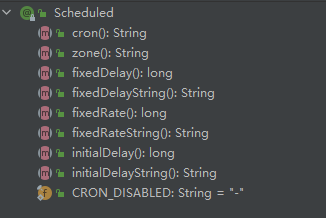springboot中使用定时任务 怎样在springboot中使用定时任务
迷茫中守候 人气:0在日常的开发过程中经常使用到定时任务,在springMVC的开发中,经常和quartz框架进行集成使用,但在springboot中没有这么做,而是使用了java的线程池来实现定时任务。
一、概述
在springboot中使用定时任务非常简单,只需要简单的几步即可完成。
二、详述
在springboot中要使用定时任务,首先要保证环境是springboot的,这里使用的是springboot-2.1.2.release版本。在启动类上加@EnableScheduling注解,如下,
package com.example.demo;
import com.example.demo.properties.ApplicationPro;
import org.springframework.boot.SpringApplication;
import org.springframework.boot.autoconfigure.SpringBootApplication;
import org.springframework.boot.context.properties.ConfigurationProperties;
import org.springframework.boot.context.properties.EnableConfigurationProperties;
import org.springframework.scheduling.annotation.EnableScheduling;
@SpringBootApplication
@EnableConfigurationProperties({ApplicationPro.class})
//引入开启定时任务的注解
@EnableScheduling
public class DemoApplication {
public static void main(String[] args) {
SpringApplication.run(DemoApplication.class, args);
}
}
@EnableScheduling注解的作用就是开启对定时任务的支持,这个注解的作用是开启定时任务的自动配置。
在使用了@EnableScheduling注解后便可以编写具体的定时任务的job类,该job类无需继承或实现任何接口,只要是一个被spring管理的类即可。为了使spring可以管理统一使用@Component注解标识。在定时任务的类中的方法上标识@Scheduled注解便可以定时执行该方法,@Scheduled注解上有几种不同的属性,看具体的该注解的定义,


fixedDelay
@Scheduled(fixedDelay=1000)/@Scheduled(fixedDelay="1000")的意思是该方法执行完后每隔1000ms执行一次。看具体的代码
package com.example.demo.job;
import lombok.extern.slf4j.Slf4j;
import org.springframework.scheduling.annotation.Scheduled;
import org.springframework.stereotype.Component;
@Slf4j
@Component
public class SchedulFixedRelayTest {
//@Scheduled(fixedDelay = 5000)
public void jobTest(){
try {
log.info("使用fixedDelay的定时任务");
Thread.sleep(10*1000);
} catch (InterruptedException e) {
e.printStackTrace();
}
}
}
看执行结果,
2020-12-09 22:02:47.511 INFO 7368 --- [ main] o.s.web.context.ContextLoader : Root WebApplicationContext: initialization completed in 940 ms 2020-12-09 22:02:47.681 INFO 7368 --- [ main] o.s.s.concurrent.ThreadPoolTaskExecutor : Initializing ExecutorService 'applicationTaskExecutor' 2020-12-09 22:02:47.782 INFO 7368 --- [ main] o.s.s.c.ThreadPoolTaskScheduler : Initializing ExecutorService 'taskScheduler' 2020-12-09 22:02:47.802 INFO 7368 --- [ scheduling-1] c.e.demo.job.SchedulFixedRelayTest : 使用fixedDelay的定时任务 2020-12-09 22:02:47.820 INFO 7368 --- [ main] o.s.b.w.embedded.tomcat.TomcatWebServer : Tomcat started on port(s): 8080 (http) with context path '' 2020-12-09 22:02:47.823 INFO 7368 --- [ main] com.example.demo.DemoApplication : Started DemoApplication in 1.627 seconds (JVM running for 2.51) 2020-12-09 22:03:02.819 INFO 7368 --- [ scheduling-1] c.e.demo.job.SchedulFixedRelayTest : 使用fixedDelay的定时任务 2020-12-09 22:03:17.834 INFO 7368 --- [ scheduling-1] c.e.demo.job.SchedulFixedRelayTest : 使用fixedDelay的定时任务
看上面打印的执行时间,第一次在2020-12-09 22:02:47,由于程序会睡眠10秒,也就是说回在22:02:57执行完,那么下次执行应该在22:03:02,看第二次打印的时间刚好和上面的一样,那就证明了,该配置是在方法执行完成后每隔XX秒执行一次。
fixedRate
@Scheduled(fixedRate=1000)/@Scheduled(fixedRate="1000")的意思是该方法执行完后每隔1000ms执行一次,但是如果任务执行的时间超过了配置的时间,则在任务执行完会再次执行。
任务时间小于配置的时间
package com.example.demo.job;
import lombok.extern.slf4j.Slf4j;
import org.springframework.scheduling.annotation.Scheduled;
import org.springframework.stereotype.Component;
@Slf4j
@Component
public class SchedulFixedRateTest {
@Scheduled(fixedRate = 5000)
public void jobTest(){
try {
log.info("使用fixedRate的定时任务");
Thread.sleep(1*1000);
} catch (InterruptedException e) {
e.printStackTrace();
}
}
}
任务会睡眠1s也就是任务耗时1s,fixedRate配置的是每隔5s,由于任务时间小于配置的时间,所以会每隔5s执行一次,看执行结果,
2020-12-09 22:16:16.156 INFO 2800 --- [ scheduling-1] c.example.demo.job.SchedulFixedRateTest : 使用fixedRate的定时任务 2020-12-09 22:16:16.188 INFO 2800 --- [ main] o.s.b.w.embedded.tomcat.TomcatWebServer : Tomcat started on port(s): 8080 (http) with context path '' 2020-12-09 22:16:16.188 INFO 2800 --- [ main] com.example.demo.DemoApplication : Started DemoApplication in 1.625 seconds (JVM running for 2.462) 2020-12-09 22:16:21.178 INFO 2800 --- [ scheduling-1] c.example.demo.job.SchedulFixedRateTest : 使用fixedRate的定时任务 2020-12-09 22:16:26.180 INFO 2800 --- [ scheduling-1] c.example.demo.job.SchedulFixedRateTest : 使用fixedRate的定时任务
看打印的任务时间都是每隔5s执行一次。
任务时间大于配置的时间
看任务的执行时间打印配置的时间的情况,
package com.example.demo.job;
import lombok.extern.slf4j.Slf4j;
import org.springframework.scheduling.annotation.Scheduled;
import org.springframework.stereotype.Component;
@Slf4j
@Component
public class SchedulFixedRateTest {
@Scheduled(fixedRate = 5000)
public void jobTest(){
try {
log.info("使用fixedRate的定时任务");
Thread.sleep(10*1000);
} catch (InterruptedException e) {
e.printStackTrace();
}
}
}
这里任务执行10s,配置的时间为5s。看执行结果,
2020-12-09 22:17:44.070 INFO 12952 --- [ scheduling-1] c.example.demo.job.SchedulFixedRateTest : 使用fixedRate的定时任务 2020-12-09 22:17:44.102 INFO 12952 --- [ main] o.s.b.w.embedded.tomcat.TomcatWebServer : Tomcat started on port(s): 8080 (http) with context path '' 2020-12-09 22:17:44.102 INFO 12952 --- [ main] com.example.demo.DemoApplication : Started DemoApplication in 1.626 seconds (JVM running for 2.462) 2020-12-09 22:17:54.071 INFO 12952 --- [ scheduling-1] c.example.demo.job.SchedulFixedRateTest : 使用fixedRate的定时任务 2020-12-09 22:18:04.085 INFO 12952 --- [ scheduling-1] c.example.demo.job.SchedulFixedRateTest : 使用fixedRate的定时任务
从上面的结果可以看到任务是每隔10s执行一次,由于任务耗时大于了配置的时长,所以任务执行完以后便会进入下次的执行。
cron
cron表达式共7位,分别是秒、分、小时、日、月、周、年。cron表达式可以从网上找,如下,
https://cron.qqe2.com/
通过cron在线生成,分别设置值,如,0/5 * * * * ? 每隔5s执行一次,
package com.example.demo.job;
import lombok.extern.slf4j.Slf4j;
import org.springframework.scheduling.annotation.Scheduled;
import org.springframework.stereotype.Component;
@Slf4j
@Component
public class SchedulCronTest {
@Scheduled(cron = "0/5 * * * * ?")
public void jobTest(){
try {
log.info("使用cron的定时任务");
Thread.sleep(10*1000);
} catch (InterruptedException e) {
e.printStackTrace();
}
}
}
每隔5s执行一次,任务耗时10s,看下执行结果,
2020-12-09 22:41:42.718 INFO 17828 --- [ main] com.example.demo.DemoApplication : Started DemoApplication in 1.609 seconds (JVM running for 2.453) 2020-12-09 22:41:45.015 INFO 17828 --- [ scheduling-1] com.example.demo.job.SchedulCronTest : 使用cron的定时任务 2020-12-09 22:42:00.004 INFO 17828 --- [ scheduling-1] com.example.demo.job.SchedulCronTest : 使用cron的定时任务 2020-12-09 22:42:15.000 INFO 17828 --- [ scheduling-1] com.example.demo.job.SchedulCronTest : 使用cron的定时任务
可以看到是每隔15s执行一次,也就是如果配置的时间间隔小于任务耗时,那么在任务执行完后的时间间隔后再执行,在此种情况下和fixDelay的用法一致。
三、总结
本文分析了springboot中定时任务的使用,
首先,使用@EnableScheduling开启定时任务的自动配置;
其次,任务类必须受spring管理(使用@Component、@Service等注解均可);
最后,任务方法使用@Scheduled注解标识,该注解有3中不同的属性配置,fixedDelay、fixedRate、cron;
加载全部内容